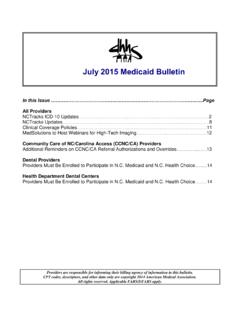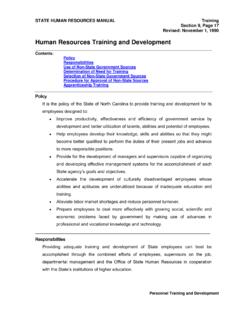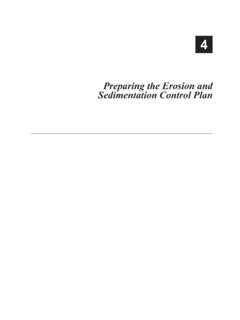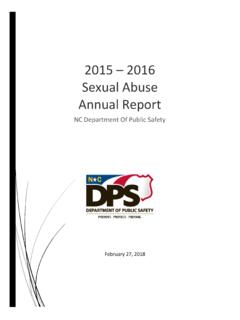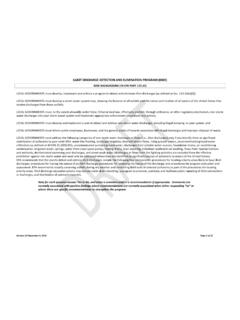Transcription of Best Practices for Law Enforcement Response - NC
1 Best Practices forBest Practices forLaw Enforcement ResponseLaw Enforcement ResponseDomestic Violence: Best Practices for Law Enforcement s ResponseNorth Carolina Governor s Crime Commission - Violence Against Women CommitteeDOMESTIC VIOLENCE:BEST Practices FOR LAW Enforcement RESPONSEA Model Policy Manual PreparedUnder the Violence Against Women ActNorth Carolina Governor s Crime CommissionViolence Against Women CommitteeJanuary 1998 Domestic Violence: Best Practices for Law Enforcement s ResponseNorth Carolina Governor s Crime Commission - Violence Against Women CommitteeJames B. Hunt of Crime Control and Public SafetySecretary Richard MooreNorth Carolina Governor s Crime CommissionLinda Hayes, ChairRobin Lubitz, DirectorViolence Against Women CommitteeWanda Bryant, ChairJane CousinsTom HaigwoodJoyce AllenJuanita BryantAnnette SheppardCatherine SmithKathy HodgesKaren LucianoMargaret HendersonRusty SherrillRon SpiveyDr.
2 David GremillionHeather WilliamsJennie LancasterPrepared by: Ada GregoryScott PetersVictims PlannerIS Policy AnalystGovernor s Crime CommissionGovernor s Crime CommissionFor more information about the Governor s Crime Commission or the Violence Against Women Committee,please contact:Governor s Crime Commission3824 Barrett Drive, Suite 100 Raleigh, North Carolina 27609(919) 571-4736e-mail: can view or obtain an electronic version of this document from the GCC web site: Violence Against Women Committee of the Governor s Crime Commission appreciates the invaluablecontributions and support provided by: John Rubin and Joan Brannon of the Institute of Government for theirthoughtful critiques; Christy Koch of the Zero Tolerance Coalition for meticulously editing the bilingualinformation.
3 And Daniel DeMeyts and Erica Wolff, whose earlier work as interns proved essential to the creationof the supplementary Violence: Best Practices for Law Enforcement s ResponseNorth Carolina Governor s Crime Commission - Violence Against Women CommitteeTABLE OF Involved in Domestic PROTOCOLS911: Dispatcher Domestic Violence Model Arrest of Protective the the Calls for Involved Domestic A: Domestic Violence Supplemental FormAppendix B: Victim s Rights Information CardAppendix C: Youth Safety PlanAppendix D: Lethality AssessmentDomestic Violence: Best Practices for Law Enforcement s ResponseNorth Carolina Governor s Crime Commission - Violence Against Women CommitteeDOMESTIC VIOLENCE:BEST Practices FOR LAW Enforcement RESPONSEINTRODUCTIOND omestic violence is one of the root causes of virtually every major socialproblem that we face in the nation RenoThe Violence Against Women Committee of the Governor s Crime Commission developed this manual to informlaw Enforcement agencies of the best methods of assisting domestic violence victims.
4 A uniform protocol willhelp to standardize the reporting and investigation of domestic violence throughout the state of North preferred arrest procedure included herein models policy endorsed by the International Association of Chiefsof Police and the American Bar Association. It follows the emerging trends in law Enforcement agencies acrossthe nation. The policy addresses the unique laws and criminal justice procedures of North Carolina to make themost progressive approaches to domestic violence relevant to local jurisdictions. The Governor s CrimeCommission (GCC) recognizes that the needs of agencies will differ based on the problems of localcommunities, and the services and resources available.
5 The GCC encourages law Enforcement executives toreview this manual critically and adapt it to their needs. This document discusses the essential backgroundinformation necessary to provide greater understanding of the philosophy behind a pro-arrest protocol and toease the implementation of the model policy in any violence is abuse between former or current intimate partners. Most often this abuse is a pattern ofphysically, psychologically and emotionally destructive behavior. Intimate relationships are defined as personswho are married, separated, or divorced, who live or have lived together, who have a child in common, or whoare or were definition is based on North Carolina laws which recognize that domestic violence relationships extendbeyond live-in or marital relationships.
6 As of December 1, 1997, NCGS 50-B, which regulates civil protectionorders, includes dating relationships between members of the opposite sex and relationships between current orformer household members whether of the same or opposite sex. NCGS 50-B also recognizes abuse by an adultchild and child abuse; however, this protocol is specifically designed to address domestic violence, not familyviolence. Child abuse is mentioned, but a separate standard operating procedure is necessary to address theunique laws and reporting requirements of child abuse. This protocol limits the statutory definition of NCGS 50-Bby excluding other family members, such as children or parents, and individuals living together in a situation inwhich the relationship is usually not considered intimate, such as a dormitory or rooming may want to extend their departmental definition by including same sex dating relationships in whichthe victim and the batterer do not live together, nor have in the past.
7 To date, that is the only dating relationshipexcluded from protection by 50-B. Dating relationships between members of the same sex can be just as violentand threatening as any opposite sex relationship. Although the legal remedies are limited for this population,officers should be aware of the presence of domestic violence. They should conduct and document thoroughinvestigations, and provide the victim with safety information and referrals. Officers should recognize domesticviolence in all the purpose of warrantless arrest only, the North Carolina legal definition of domestic violence is limited tomembers of the opposite sex who are former of current spouses or live-in partners.
8 All dating relationships, samesex relationships and couples with a child in common are excluded. Although the criminal legal remedies forthese relationships differ, officers can still make arrest pursuant to a warrant, safety plan with victims and makereferrals to victim service Violence: Best Practices for Law Enforcement s ResponseNorth Carolina Governor s Crime Commission - Violence Against Women CommitteeNorth Carolina statutes recognize certain assault and trespass crimes as domestic violence crimes for purposesof arrest (NCGS. 15A-401(b)2); however, abuse may encompass a myriad of crimes. Any violent act may beconsidered domestic violence related if an intimate relationship exists between the offender and victim.
9 Arelatively minor offense, such as vandalism, may be viewed as a much more threatening crime when consideredin the context of an escalating domestic violence relationship. The common domestic crimes include, but are notlimited to, homicide, rape, assault, breaking and entering, burglary, trespass, kidnapping, damage to property,cruelty to animals, harassing phone calls, and communicating threats. All domestic violence cases should behandled according to this policy, regardless of the perceived severity of the grammatical purposes, the feminine pronoun may be used to describe the victim and the masculine todescribe the offender. However, this is not to say there are not male victims, both gay and heterosexual, andfemale batterers.
10 Some husbands/boyfriends are abused; however, the vast majority of domestic violencevictims are women. According to FBI statistics, 26% of female homicide victims are murdered by their intimatepartners, compared to 3% of males. A woman is seven times more likely to experience nonfatal violence by anintimate than a man.(FBI, Crime in the United States 1995: Uniform Crime Reports, and BJS, Violence AgainstWomen: Estimates from the Redesigned Survey, August 1995, NCJ-15438.) In a North Carolina study of femalehomicides, 51% of female victims were murdered by an intimate. (Injury Prevention Research Center, 1997)Regardless of gender, every victim should be afforded protection and no permanent injury has been inflicted, nor malice, cruelty, nor dangerousviolence shown by the husband, it is better to draw the curtain, shut out thepublic gaze, and leave the parties to forgive and of North Carolina Vs.

